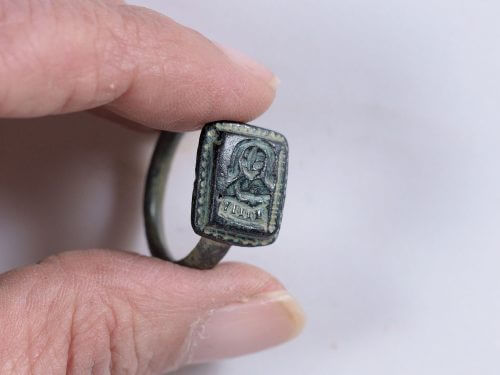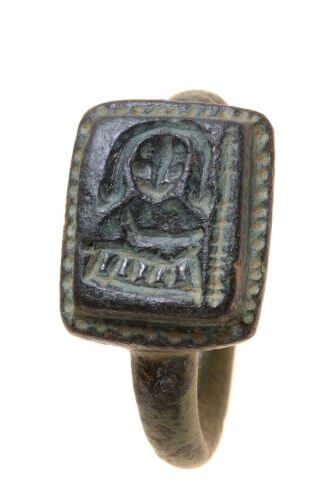An impressive and rare ring about 700 years old, with the image of St. Nicholas on it, was discovered by a gardener in Moshav HaYogev

The gardener, Dekal ben Shtrit, handed over the special object to the State Treasures, and the Antiquities Authority will award him a certificate of appreciation for good citizenship. Saint Nicholas is considered to be the origin of the well-known "Santa Claus" myth, who distributes gifts on Christmas night. Such a ring is not sold in the State Treasury in Israel.
Last Thursday, during gardening and weeding work in one of the gardens in Moshav HaYogev in the Jezreel Valley, the eyes of the gardener, 26-year-old Dekal Ben Shetrit, caught sight of a whole ring lying among the grass. Ben Shetrit picked up the ring, and noticed that a human figure was engraved on it. According to him, "I lightly rubbed the ring and saw a figure of a human being carved inside a frame." Ben Shtrit, who lives in Kibbutz Zorea, posted the photo of the ring on Facebook in the hope of getting information about the special object, and thus a contact was made with his neighbor to the Kibbutz, Dr. Dror Ben Yosef, Northern District Heritage Commissioner at the Nature and Parks Authority. Dr. Ben Yosef connected between Ben Sheetrit and the Antiquities Authority.
The ancient ring, which dates back to the 15th-12th centuries AD, was examined by Dr. Jana Chakhanovitch, an archaeologist specializing in the Byzantine period at the Antiquities Authority. According to her, "the state of preservation of the ring is exceptional, and the research on the special object will contribute to science; On the ring is carved the image of a bald man with a stick next to him. From a preliminary point of view, it seems that this is St. Nicholas holding a bishop's staff - the hallmark associated with him. In the Eastern Christian world, Saint Nicholas is considered the patron saint of travelers, including pilgrims and sailors. Against this background, the Christian pilgrims who came to the Land of Israel from around the Byzantine Empire (Turkey, the Balkans, Greece and also today's Russia) used to carry an icon (image) of Saint Nicholas on their body, which would protect them from any harm. It is not impossible that the ring found now belonged to a pilgrim who also asked for Nikolaos' protection." St. Nicholas was attributed the qualities of 'doing miracles' and giving gifts in secret, and in the Western Christian world he is attributed the myth of 'Santa Claus', who distributes gifts on Christmas night."

Moshav HaYogev is located in the Jezreel Valley, east of the Tel Megiddo National Park and the sites from the Roman and Byzantine periods in the nearby regions. According to Dr. Yotam Teper, an archaeologist at the Israel Antiquities Authority who specializes in Roman roads, "we know that the main road from Legio to Mount Tabor passed near Moshav HaYogev, and it seems that since then the road also served the Christian pilgrims on their way to the holy sites on Mount Tabor, in Nazareth and around the Sea of Galilee." .
Nir Distelfeld, the inspector from the robbery prevention unit at the Antiquities Authority who collected the ring from Ben Shetrit in order to attach it to the state treasures, wanted to praise the good behavior of the gardener Ben Shetrit. "We thank Ben Shitrit for handing over the ancient object to the Antiquities Authority and encourage citizens to do so. Such actions enrich and deepen the accumulated archaeological knowledge about the past of all of us. The Antiquities Authority will award Ben Sheetrit a certificate of appreciation for good citizenship."
